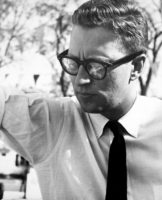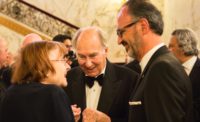Obituary: Ricardo Porro, 1925-2014

Cuban architect Ricardo Porro died December 25 of heart failure in Paris. He was the leading creator of the most outstanding and controversial architectural achievement of the Cuban Revolution, the Escuelas Nacionales de Arte. He was 89.
Ricardo Porro Hidalgo was born in 1925 in Camagüey, Cuba. As a young man he moved to the capitol where he studied architecture at the Universidad de la Habana. There he became acquainted with Fidel Castro whose best friend from law school was the brother of Porro’s fiancée Elena Freyre de Andrade y Veulans; the the three shared many mid-day dinners and boisterous conversations in the Freyre de Andrade house.
After Porro’s graduation he went to Paris, where he was inspired by Cuban painter Wifredo Lam, whose paintings explored cubanidad, or Cuba’s multi-cultural heritage, with an emphasis on Afro-Cuban iconography. Lam was a committed Marxist, as Porro would become. Under Lam’s influence Porro condemned International Style modernism as practiced by Cuba’s prominent architects, and expounded an organic modernism that would more honestly express cubanidad. While a great admirer of Antonin Gaudi and Frank Lloyd Wright, Porro’s organic architecture became uniquely his own.
As the 1950s unfolded he became increasingly involved in the clandestine movement against the dictatorship of Fulgencio Batista, often putting himself at great risk. After the failed General Strike of April 1957, his arrest was immanent, and Porro and his young wife Elena fled to Venezuela.
But with the triumph of the Revolution, Porro returned to Cuba and brought along two Italian colleagues from Venezuela, Roberto Gottardi and Vittorio Garatti. The three architects went on to create what would make their place in history, Las Escuelas Nacionales de Arte, five schools sited on what had been Havana’s most exclusive country club. They agreed on three fundamental principles: respect for the existing verdant landscape, building with terracotta brick and tiles, and the use of the Catalan vault, which became the formal signature for the Escuelas Nacionales de Arte. Porro designed two schools: the Escuela de Danza Moderna, which expressed the ambiguity and violence of the revolutionary moment, and the Escuela de Artes Plasticas, which expressed most fully the “arquitectura negra” he so longed to delineate in architectural form.
But in a short time the art schools and their architects fell from grace and were subjected to attacks. Porro was particularly singled out by architectural critic Roberto Segre, who accused him of being an elitist cultural aristocrat whose work exhibited a "narcissistic and egocentric bourgeois formation.” Porro also had an enemy in Antonio Quintana, the architect in charge of design for the new Ministry of Construction. Quintana was an unreconstructed modernist who saw the organic, expressive forms rising from the country club landscape as unforgiveable architectural heresy and threat. The attacks by Quintana and his subordinates brought construction to a halt in 1965 and the five schools lay in various stages of use and abandonment.
Castro, who considered the schools to be “la mas bella academia de arte de todo el mundo,” met privately with Porro and tried to rectify matters, but the situation was intractable. Castro reluctantly granted Porro’s request for permission to depart and in 1966 he and his family moved to Paris where Andre Malraux helped him find shelter and work. He rebuilt his architectural practice and much of his work there served the working class Communist banlieue. “I have always been an architect for the workers, immigrants, and the poor,” he stated.
In late 1980s Cuba, perestroika and glasnost were taking on a Cuban identity. By 1996 all was forgiven, and Porro was officially invited back to Cuba with much acclaim and celebration, the first of several repeat visits. In the fall of 1999 Castro ordered the rehabilitation and completion of the five art schools, a process still slowly moving forward.
In a late interview, Mexican journalist Alma Guillermoprieto asked Porro, “What do you consider your greatest achievement?” He replied, “I consider my greatest achievement to be the adventure of knowing another person as deeply and as profoundly as I know myself—my wife Elena.”
Porro is survived by his wife Elena Freryre de Andrade de Porro and his daughter Gabriela Porro.






